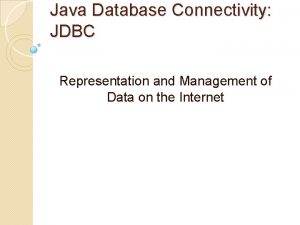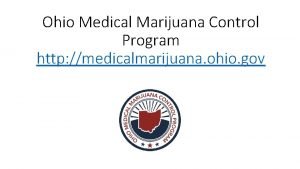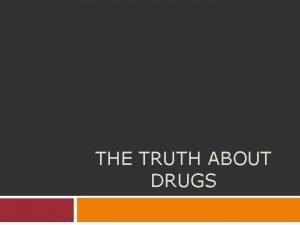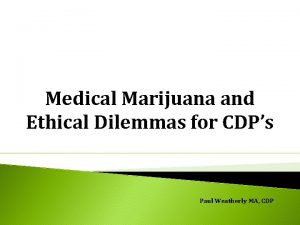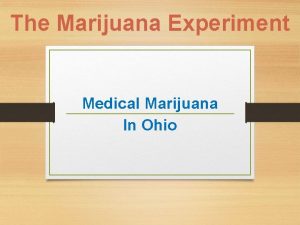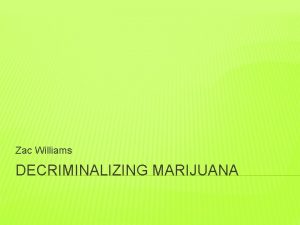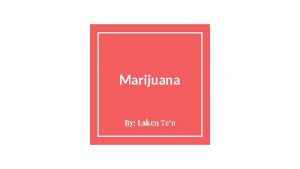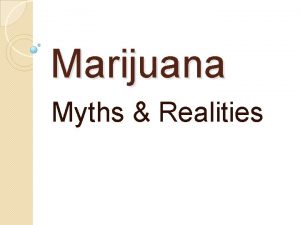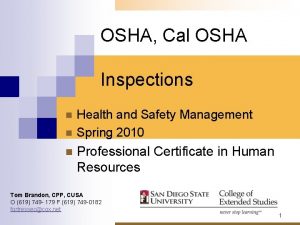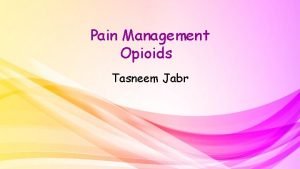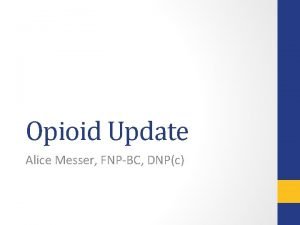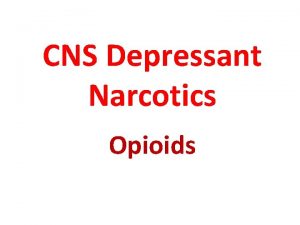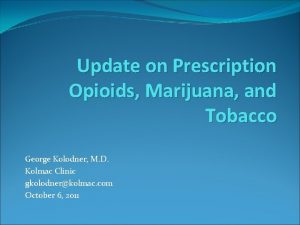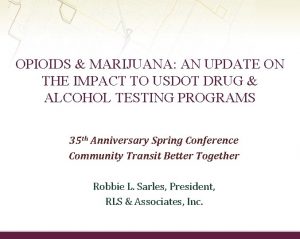Marijuana and Opioids in the Workplace CONN OSHA




















































- Slides: 52

Marijuana and Opioids in the Workplace CONN - OSHA February 18, 2020 David S. Jaffe, Vice President, Legal Advocacy National Association of Home Builders

What is Marijuana, which can also be called weed, pot, dope, or cannabis, is the dried flowers and leaves of the cannabis plant. It contains mind-altering (e. g. , psychoactive) compounds like tetrahydrocannabinol, or THC, as well as other active compounds like cannabidiol or CBD, that are not mind-altering. Source: Centers for Disease Control and Prevention

Marijuana is Illegal Under Federal Law § Marijuana is a Schedule 1 controlled substance under the Controlled Substances Act (CSA) § Schedule 1 drugs and substances are defined as drugs with no currently accepted medical use in treatment and high potential for abuse As such, the CSA makes it a federal crime to use, possess, or distribute marijuana

Modes of Ingestion/Use Currently Available Medical Cannabis Vaporizers – inhale mist Edibles - Eat Topicals & Sprays – apply to skin Pills Liquid Extracts/Tinctures – place under tongue § Plant § § §

Marijuana Addiction § Contrary to popular belief, marijuana is addictive. Research shows that: § 1 -in-6 people who start using the drug before the age of 18 can become addicted. § 1 -in-10 adults who use the drug can become addicted. § Source: Substance Abuse and Mental Health Services Administration (SAMHSA)

Why Employers Should Care Cannabis (also known as marijuana) can impair cognition, attention and intellectual performance, though the effects are reversible. And in some individuals who are genetically at risk, it can unleash psychotic states.

Why Employers Should Care § A 2016 Joint Guidance Statement of the American Association of Occupational Health Nurses and the American College of Occupational and Environmental Medicine noted the “potential consequences of marijuana use in the workplace include the risk and associated cost of adverse events and the loss of productivity. ” § Construction workers are at an increased risk for drug use, which makes them vulnerable to work-related injuries or even overdose deaths. § Compared to all other professions, construction workers had the second highest prevalence of marijuana use after those in service jobs. Source: Center for Drug Use and HIV/HCV Research at NYU College of Global Health (October 2019)

What Are Opioids? Opioids are narcotics that are derived from the opium poppy or its synthetic version, and include the illegal drug heroin, synthetic opioids such as fentanyl, and pain relievers available legally by prescription. Examples of commonly prescribed opioids include hydrocodone (e. g. , Vicodin), oxycodone (e. g. , Oxy. Contin, Percocet), morphine (e. g. , KADIAN®, Avinza®), and codeine.

Why Employers Should Care According to a recent study, work-related injuries contribute to the rapid increase in deaths from both opioids and suicides. An injury serious enough to lead to at least a week off of work almost tripled the combined risk of suicide and overdose death among women, and increased the risk by 50 percent among men. Source: American Journal of Industrial Medicine (July 2019)

Why Employers Should Care Illness Turnover Health benefit costs Accidents and injuries Theft and risk of violence Depression and suicidality Absenteeism and presenteeism § Workers compensation and disability costs § Customer dissatisfaction with inferior products § § § §

Legalization of Marijuana is legal for medical use in 33 states, the District of Columbia, Guam and Puerto Rico. Connecticut allows the use of marijuana for medical reasons. This conflict with federal law presents new and unique challenges for employers.

Legalization of Marijuana Recreational use of marijuana is now legal in 11 states and the District of Columbia. States generally limit use to adults 21 years and older and restrict authorized amounts. In states where recreational cannabis has been legalized, adult consumers do not need a medical marijuana card, but may not have access to the same medical cannabis products that are available for patients.

Marijuana in Connecticut Recreational Use of Marijuana is Decriminalized In general, decriminalization means no prison time or criminal record for first-time possession of a small amount for personal use. However, recreational use and possession is still prohibited. Legislative leaders and Gov. Ned Lamont have made it clear that they intend to make a stronger push for legalization in 2020.

More Employees Are Testing Positive for Marijuana at Work Marijuana is the most commonly used illegal substance in the U. S. One third of U. S. industry sectors, including construction, experienced year-over-year double-digit increases in workforce drug positivity between 2015 and 2018. Increases in positivity rates for marijuana in the general U. S. workforce were most striking in states that have enacted recreational use statues since 2016. “While it is too early to tell if this is a trend, our data suggests that the recreational use of marijuana is spilling into the workforce…” Source: Quest Diagnostics Drug Testing Index™ (May 2018)

The Conflict Can employers object to their employees’ use of marijuana at work? Can an employer refuse to hire an employee because they admitted to using medical marijuana? Can an employer fire an employee because they fail a drug test because of medical marijuana, even if the employee was never found to be impaired?

The Conflict Medical marijuana laws vary by state, and only some states include explicit employment protections for the use of medical marijuana. In many states, it remains unclear what protections, if any, workers have for the use of medical marijuana.

Connecticut Employment-Related Issues with Medical Marijuana Under Connecticut’s Palliative Use of Marijuana Act, Connecticut residents who are at least 18 years of age and have been diagnosed by a physician with a “debilitating medical condition” may register as “qualifying patients” with the Department of Consumer Protection. C. G. S. Sec. 21 a-408 “Qualifying patients, ” after obtaining a physician’s written certification for the palliative use of marijuana, shall not be subject to arrest or prosecution, penalized in any manner, including, but not limited to, being subject to any civil penalty, or denied any right or privilege…C. G. S. Sec. 21 a-408 a

Can I Regulate My Employees’ Use of Marijuana? YES! PUMA does not restrict an employer's ability to prohibit the use of intoxicating substances during work hours or restrict an employer's ability to discipline an employee for being under the influence of intoxicating substances during work hours. C. G. S. Sec. 21 a-408 p(3)

Employers May Not Discriminate Against Medical Marijuana Users “No employer may refuse to hire a person or may discharge, penalize or threaten an employee solely on the basis of such person's or employee's status as a qualifying patient…” C. G. S. Sec. 21 a-408 p(3) The law does not require a person or entity to do any act that would put it in violation of federal law or cause it to lose a federal contract.

Legal Challenge Under PUMA § Noffsinger v. SSC Niantic Operating Company LLC (D. Conn. August 2017) § Prospective employee alleged denial of employment in violation of PUMA § Prospective employer rescinded a job offer based on positive cannabis result during pre-employment screening test § Prospective employer was aware that prospective employee suffered from Post Traumatic Stress Disorder and was a qualifying patient under PUMA

Legal Challenge Under PUMA § Defendant employer argued that federal law – specifically, the Controlled Substances Act, The Americans with Disabilities Act, and the Food, Drug, and Cosmetic Act - precluded enforcement of PUMA § Holding: Federal law did not preempt (conflict with) PUMA’s antidiscrimination provision and an individual who uses marijuana for medicinal purposes in compliance with Connecticut law may maintain a cause of action against an employer who refuses to employ her for this reason

Barbuto v. Advantage Sales and Marketing (Mass. 2017) Christina Barbuto suffers from Crohn’s disease, and in accordance with Massachusetts law, legally used medical marijuana to treat her condition. Ms. Barbuto accepted a job offer with Advantage, which required her to take a pre-employment drug test. Before taking the test, she told the company she had Crohn’s disease and used marijuana to treat it. After starting work, Ms. Barbuto was informed she had tested positive for marijuana, and under the company policy was terminated.

Barbuto, cont’d Ms. Barbuto brought a handicap discrimination claim under Massachusetts’s anti-discrimination law for Advantage’s failure to accommodate a legal treatment for her disability, Crohn’s disease. The Supreme Court held that, notwithstanding that marijuana was illegal under federal law, accommodation of the use of medical marijuana was not per se unreasonable and that at a minimum, Advantage should have gone through an interactive process with Ms. Barbuto to consider accommodations before terminating her. At summary judgment or trial Advantage could offer evidence that medical marijuana was not a reasonable accommodation because it would impose an undue hardship on its business, such as significant safety risks. However, there is no implied statutory private cause of action under the medical marijuana act.

Employer Points Legalization of marijuana does not mean that employees can be impaired at work. Employers need not accommodate marijuana use in any workplace, even if: § The employee has a medical cannabis prescription; or § The employer’s place of business is in a state that has legalized marijuana for recreational purposes In particular, employers may choose to adopt or maintain a zero-tolerance policy and may take action against offenders.

Employer Points Unless expressly provided for by statute, most courts have concluded that the decriminalization of medical marijuana does not shield employees from adverse employment actions. The fundamental problem with the Plaintiff’s case is that the [Michigan Medical Marijuana Act} does not regulate private employment. Rather the Act provides a potential defense to criminal prosecution or other adverse action by the state. Casias v. Wal-mart Stores, Inc. (W. D. Mich. 2011, aff’d 6 th Cir. 2012). However…

The Opioid Epidemic § A staggering number of Americans are dying from overdoses attributed to prescription opioid medications § Every day, more than 130 people in the United States die after overdosing on opioids (more than 47, 000 – 69. 5% of all overdose deaths ) - the equivalent of a daily plane crash. § Synthetic opioids (such as fentanyl), heroin, and common opioid painkillers (like Percocet and Oxy. Contin) top other causes of overdose

The Opioid Epidemic - Connecticut § Historically, Connecticut has been among the states with the highest rates of opioid-related overdose deaths. § Residents are more likely to die from unintentional drug overdose than a motor vehicle accident. § The majority of these deaths are linked to overdose of prescription opioid painkillers and illicit opioids. Source: National Institute on Drug Abuse - https: //www. drugabuse. gov/drugsabuse/opioids/opioid-summaries-by-state/connecticut-opioid-summary Source: https: //portal. ct. gov/DPH/Health-Education-Management--Surveillance/The -Office-of-Injury-Prevention/Opioids-and-Prescription-Drug-Overdose-Prevention. Program

The Opioid Epidemic - Connecticut § The rate of overdose deaths in Connecticut increased from 9. 9 per 100, 000 residents in 2012 to 28. 5 per 100, 000 residents in 2018—a 221 % increase— The greatest increase in opioid deaths was seen in cases involving synthetic opioids (mainly fentanyl): a rise from 79 deaths in 2016 to 686 in 2017. Source: https: //www. drugabuse. gov/drugs-abuse/opioids/opioid-summaries-bystate/connecticut-opioid-summary

The Opioid Epidemic – Connecticut County Data A new study suggests that the US opioid epidemic is actually several different epidemics occurring at the same time Fairfield County – Emerging Heroin Hartford County - Opioid Syndemic Litchfield County – Opioid Syndemic Middlesex County - Opioid Syndemic New Haven County – High Heroin New London County - Opioid Syndemic Tolland County - Synthetic+Prescription Windham County - Opioid Syndemic Source: The Opioid Hydra: Understanding Overdose Mortality Epidemics and Syndemics Across the Rural-Urban Continuum, Rural Sociology (2019)

Opioid Use and Connecticut’s Workforce The Connecticut Department of Public Health’s Occupational Health Unit has developed a set of recommendations that outlines a more progressive, disease-based approach to employee addiction and substance use policy development. Companies should revise their workplace substance use policies to shift the focus from stigmatization to an emphasis on support and care.

Opioid Use and Connecticut’s Workforce – Recommended Policies

Opioid Use and Connecticut’s Workforce – Recommended Policies, Cont’d • Regular review of progress toward recovery and adjustment to reentry into the workplace • Enlisting success by tapping into the knowledge and experience of employees who have navigated similar struggles. Source: https: //portal. ct. gov/opioidsworkplace

Opioid Use and Connecticut’s Workforce – Change the Script is a new statewide campaign that connects town leaders, healthcare professionals, treatment professionals and everyday people whose lives are affected by the crisis. With Change the Script, people can access the resources they need to face opioid misuse and write a new story about how we deal with this issue. Ready-to-use materials are intended to raise awareness of the risks of addiction to prescription opioids. Source: https: //portal. ct. gov/DMHAS/Prevention-Unit/Prevention-Files/Changethe-Script

What Does This Have to Do with the Home Building Industry? A 2019 study found that construction workers are the most likely of all occupations to use cocaine and misuse prescription opioids. “The hazards of this type of work – result in high injury and fatality rates. In particular, injuries from repetitive, strenuous work can lead to treatment or self-treatment with pain medication such as marijuana or opioids. ” Source: Center for Drug Use and HIV/HCV Research at New York University’s College of Global Health (October 2019)

What Does This Have to Do with the Home Building Industry? 2017 study revealed that construction workers are among the most susceptible to opioid abuse, second only to food service industry employees. The average construction worker addicted to opioids has been on pain medications for at least six months. The fatal overdose rate among construction workers is 6 times what it is in the greater population.

What Does This Have to Do with the Home Building Industry? $6. 8 K § Each construction worker with an untreated substance abuse disorder costs an employer $6, 800 per year in excess healthcare expenses, absenteeism, and turnover costs. $2. 4 K § § But when a construction employee is in recovery from a substance abuse disorder, contractors save nearly $2, 400 per year. Research has confirmed that opioids are not more effective than non-opioid painkillers for most pain. Source: Midwest Economic Policy Institute (MEPI) Economic Commentary, 2018

Lamont And Tong Stand With Construction Workers On Opioid Addiction Awareness

What Does This Have to Do with the Home Building Industry? Construction industry to workers battling addiction: ‘We want to help’ By John Hilliard Globe Correspondent, April 28, 2019, 9: 05 p. m.

P. A. A. R. I. Launches First Recovery. Friendly Construction Site Program

Recovery-Friendly Construction Site Program Launched – June 2019 v NARCAN training v Distribution of customized NARCAN kit – wallmounted v Recovery support – • Reduce stigma surrounding the opioid epidemic • Help individuals connect with treatment and services

How Employers Can Make a Difference Employers can take simple steps to protect themselves and their employees: Recognize prescription drugs impact the bottom line Enact strong company drug policies Expand drug panel testing to include opioids Train supervisors and employees to spot the first signs of drug misuse § Treat substance abuse as a disease § Leverage employee assistance programs to help employees return to work § §

Written Policy A clearly written policy forms the foundation of your drug-free workplace program. At minimum, your policy should include: § The rationale for the policy, such as organizational goals and compliance with laws or regulations § Expectations for compliance, including who, what, when, and where § Assistance options to support employees in following the policy § Consequences for violating the policy

Drug Testing - Connecticut § Connecticut has a drug testing statute, Conn. Gen. Stat. § 31 -51 t et seq. § Applies to any individual, corporation, partnership or association except for the state or a subdivision thereof.

Pre-Employment Drug Testing Permits employers to require pre-employment urinalysis alcohol and drug tests so long as: § The prospective employee is informed in writing at the time of application of the employer's intent to conduct such a drug test § The drug test is conducted using a reliable methodology and if positive, confirmed by a second test which is separate and utilizing a gas chromatography and mass spectrometry methodology § The prospective employee is given a copy of any positive drug test result (the results shall be confidential)

Drug Testing of Current Employees Permissible if – The employer has reasonable suspicion that the employee is under the influence of drugs or alcohol which adversely affects or could adversely affect such employee's job performance.

Random Drug Testing of Current Employees An employer may require an employee to submit to a urinalysis drug test on a random basis if: § Such test is authorized under federal law § The employee serves in an occupation which has been designated as a high-risk or safetysensitive occupation pursuant to regulations adopted by the Labor Commissioner § The urinalysis is conducted as Part of an Employee Assistance Program in which the employee voluntarily participates

Random Drug Testing – Reasonable Suspicion Common examples of reasonable suspicion include but are not limited to: § Irregular behavior § Substantial deterioration in work performance § Physical symptoms of drug use (uncoordinated movement, smell, etc. ) § Direct observation of drug use § Report from a reliable source that an employee is using drugs § Evidence that the employee has used, possessed, sold or solicited, transferred drugs while at work

NAHB Resources To learn more about the marijuana laws and their impact on the workplace NAHB has prepared the following two resources: Dazed and Confused: The Buzz Surrounding Legalized Marijuana in the Workplace. This on-demand webinar discusses the differences between state and federal laws and examines the ways the legalization of both medical and recreational marijuana can impact the home building industry. A Builder’s Guidebook: Marijuana in the Home Building Industry. The guide examines pertinent issues related to the legalization of marijuana, and includes a compilation of state laws, tips for creating a workplace policy and answers to frequently asked questions.

Opioid Resources In 2019, after 2 years of work, NAHB completed the initial phase of its opioid initiative “Opioids in the Home Building Industry: Making it Your Business. ” It aligns with NAHB’s workplace safety objectives by offering specific education and training designed to protect the health and well-being of those involved in the industry and the related trades. Working with experts in the field of drug abuse, we created a unique set of resources tailored specifically to the residential construction industry.

Opioid Resources Our goals from the outset were to: v Raise awareness within the industry v Educate and inform builders, employees, subcontractors, and their families, and v Help them to take action.

Opioid Resources Our goals from the outset were to: v Raise awareness within the industry v Educate and inform builders, employees, subcontractors, and their families, and v Help them to take action.

THANK YOU David Jaffe Vice President, Legal Advocacy djaffe@nahb. org 800 -368 -5242 x 8317 We Build Communitites ®
 Opioids for neuropathic pain
Opioids for neuropathic pain Osce data interpretation
Osce data interpretation Conn's syndrome
Conn's syndrome Conn's syndrome
Conn's syndrome Preparedstatement pstmt = conn.preparestatement(sql)
Preparedstatement pstmt = conn.preparestatement(sql) Diaporama a la conn.fr
Diaporama a la conn.fr Conn plus
Conn plus Principal cells
Principal cells Brown weeds
Brown weeds Orc 3796
Orc 3796 Became marijuana state
Became marijuana state Should marijuana be a medical option
Should marijuana be a medical option Lungs marijuana
Lungs marijuana Marijuana names
Marijuana names Medical marijuana ethics
Medical marijuana ethics Hình ảnh bộ gõ cơ thể búng tay
Hình ảnh bộ gõ cơ thể búng tay Slidetodoc
Slidetodoc Bổ thể
Bổ thể Tỉ lệ cơ thể trẻ em
Tỉ lệ cơ thể trẻ em Gấu đi như thế nào
Gấu đi như thế nào Chụp phim tư thế worms-breton
Chụp phim tư thế worms-breton Chúa yêu trần thế alleluia
Chúa yêu trần thế alleluia Môn thể thao bắt đầu bằng từ đua
Môn thể thao bắt đầu bằng từ đua Thế nào là hệ số cao nhất
Thế nào là hệ số cao nhất Các châu lục và đại dương trên thế giới
Các châu lục và đại dương trên thế giới Cong thức tính động năng
Cong thức tính động năng Trời xanh đây là của chúng ta thể thơ
Trời xanh đây là của chúng ta thể thơ Cách giải mật thư tọa độ
Cách giải mật thư tọa độ 101012 bằng
101012 bằng Phản ứng thế ankan
Phản ứng thế ankan Các châu lục và đại dương trên thế giới
Các châu lục và đại dương trên thế giới Thơ thất ngôn tứ tuyệt đường luật
Thơ thất ngôn tứ tuyệt đường luật Quá trình desamine hóa có thể tạo ra
Quá trình desamine hóa có thể tạo ra Một số thể thơ truyền thống
Một số thể thơ truyền thống Cái miệng xinh xinh thế chỉ nói điều hay thôi
Cái miệng xinh xinh thế chỉ nói điều hay thôi Vẽ hình chiếu vuông góc của vật thể sau
Vẽ hình chiếu vuông góc của vật thể sau Nguyên nhân của sự mỏi cơ sinh 8
Nguyên nhân của sự mỏi cơ sinh 8 đặc điểm cơ thể của người tối cổ
đặc điểm cơ thể của người tối cổ V cc cc
V cc cc Vẽ hình chiếu đứng bằng cạnh của vật thể
Vẽ hình chiếu đứng bằng cạnh của vật thể Vẽ hình chiếu vuông góc của vật thể sau
Vẽ hình chiếu vuông góc của vật thể sau Thẻ vin
Thẻ vin đại từ thay thế
đại từ thay thế điện thế nghỉ
điện thế nghỉ Tư thế ngồi viết
Tư thế ngồi viết Diễn thế sinh thái là
Diễn thế sinh thái là Dot
Dot Số nguyên tố là gì
Số nguyên tố là gì Tư thế ngồi viết
Tư thế ngồi viết Lời thề hippocrates
Lời thề hippocrates Thiếu nhi thế giới liên hoan
Thiếu nhi thế giới liên hoan ưu thế lai là gì
ưu thế lai là gì Khi nào hổ con có thể sống độc lập
Khi nào hổ con có thể sống độc lập




